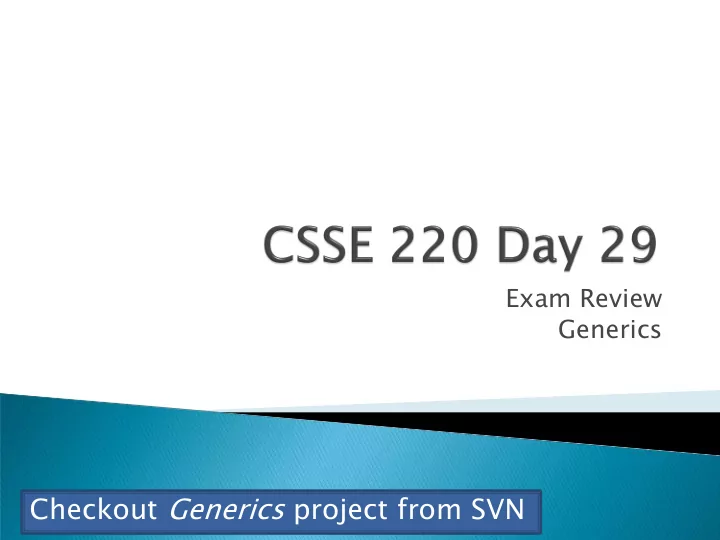

Exam Review Generics Checkout Generics project from SVN
Business casual Think of it as an internal company presentation, not a presentation to the public Five-minute presentation, two minutes for questions, two minutes for transition to next team Order of teams will be randomly determined
Do a quick demo of your project ◦ Show off any "extra" features or things that work well What part was your team's biggest challenge? Show one or two interesting code snippets ◦ Highlight your good OO design Ask for questions ◦ And a d ask sk qu questions of of oth other te teams Before Thursday, practice getting your computer working with a New Olin projector ◦ Remember maximum resulution
Exam is Monday, Feb 18 at 6:00 pm Same general format as previous exams Same resources: ◦ Paper part: 1 page of notes ◦ Computer part: Open book, notes, computer; course web pages and ANGEL pages, JDK documentation, programs in YOUR CSSE220 repositories Comprehensive, but focused on Ch 9-18 May include problems that make sure you understand your team's project code
o Simple recursion o File I/O, exception handling o Mutual recursion o Function objects o Time-space trade-offs o Linked-list o Basic search algorithms implementation o Binary search, linear o Basic data structure use search and efficiency o Efficiency, best/worst o ArrayList, LinkedList, case inputs Stack, Queue, o Big-oh notation, HashSet, TreeSet, estimating big-oh HashMap, TreeMap behavior of code o Multithreading (not locks)
Interfaces, polymorphism, inheritance and abstract classes Exception handling (try, catch, finally, throw, throws) OO design and UML class diagrams Basic sorting algorithm Insertion sort Selection sort Merge sort Big-oh analysis of each Generic programming Event handling, layout managers, exploring the Swing documentation Your LodeRunner implementation
Another way to make code more re-useful
Java Collections just stored Object s ◦ This was better than creating different collection classes for each kind of object to be stored ◦ Could put anything in them because of poly lymorphis ism Used class casts to get the types right: ◦ ArrayList songs = new ArrayList(); songs.add(new Song("Dawn Chorus", "Modern English")); … Song s = (Song) songs.get(1); ◦ songs.add(new Artist("A Flock of Seagulls")); Song t = (Song) songs.get(2); run-time error Q1
Can define collections and other classes using type parameters ◦ ArrayList<Song> songs = new ArrayList<Song>(); songs.add(new Song("Dawn Chorus", "Modern English")); … Song s = songs.get(1); // no cast needed ◦ songs.add(new Artist("A Flock of Seagulls")); compile-time Lets us use these classes: error ◦ in a variety of circumstances ◦ with strong type checking ◦ without having to write lots of casts Q2
Create a doubly linked list Include min() and max() methods Use poly olymo morphism rather than null checks for the start and end of the list Include fromArray() factory method Q3-Q5
Type parameters: ◦ class DLList<E> Bounds: ◦ class DLList<E extends Comparable> ◦ class DLList<E extends Comparable<E>> ◦ class DLList<E extends Comparable<? super E>> Generic methods: ◦ public static <T> void shuffle ( T[ ] array) http://docs.oracle.com/javase/tutorial/java/generics/index.html Q6-7, turn in
Recommend
More recommend